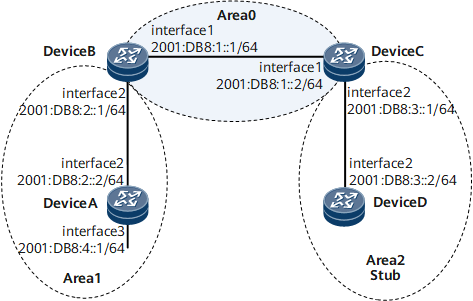Example for Configuring Basic OSPFv3 Functions
This section describes how to configure basic OSPFv3 functions, including enabling OSPF on each router and specifying network segments in different areas.
Networking Requirements
On the network shown in Figure 1, all routers run OSPFv3. The entire AS is divided into three areas. DeviceB and DeviceC serve as ABRs to forward inter-area routes.
After the configuration is complete, each router should learn the routes to all network segments in the AS.
Configuration Notes
When configuring basic OSPFv3 functions, note the following rules:
The backbone area is responsible for forwarding inter-area routes. In addition, the routing information between non-backbone areas must be forwarded through the backbone area. OSPFv3 defines the following rules for the backbone area:
- Connectivity must be available between non-backbone areas and the backbone area.
- Connectivity must be available over the backbone area.
- The intervals at which Hello, Dead, and Poll packets are sent on the local interface must be the same as those on the remote interface. Otherwise, the OSPFv3 neighbor relationship cannot be established.
Configuration Roadmap
The configuration roadmap is as follows:
Enable basic OSPFv3 functions on each router.
Specify network segments in different areas.
Data Preparation
To complete the configuration, you need the following data:
Device Name |
Router ID |
Process ID |
IPv6 Address |
Device A |
1.1.1.1 |
1 |
Area 1: 2001:DB8:4::1/64 and 2001:DB8:2::2/64 |
Device B |
2.2.2.2 |
1 |
Area 0: 2001:DB8:1::1/64 Area 1: 2001:DB8:2::1/64 |
Device C |
3.3.3.3 |
1 |
Area 0: 2001:DB8:1::2/64 Area 2: 2001:DB8:3::1/64 |
Device D |
4.4.4.4 |
1 |
Area 2: 2001:DB8:3::2/64 |
Procedure
- Assign an IPv6 address to each interface. For configuration details, see Configuration Files in this section.
- Configure basic OSPFv3 functions.
# Configure DeviceA.
[*DeviceA] ospfv3 [*DeviceA-ospfv3-1] router-id 1.1.1.1 [*DeviceA-ospfv3-1] area 0.0.0.1 [*DeviceA-ospfv3-1] quit [*DeviceA] interface gigabitethernet0/1/16 [*DeviceA-GigabitEthernet0/1/16] ospfv3 1 area 1 [*DeviceA-GigabitEthernet0/1/16] quit [*DeviceA] interface gigabitethernet0/1/8 [*DeviceA-GigabitEthernet0/1/8] ospfv3 1 area 1 [*DeviceA-GigabitEthernet0/1/8] quit [*DeviceA] commit
# Configure DeviceB.
[*DeviceB] ospfv3 [*DeviceB-ospfv3-1] router-id 2.2.2.2 [*DeviceB-ospfv3-1] area 0.0.0.0 [*DeviceB-ospfv3-1] area 0.0.0.1 [*DeviceB-ospfv3-1] quit [*DeviceB] interface gigabitethernet0/1/0 [*DeviceB-GigabitEthernet0/1/0] ospfv3 1 area 0 [*DeviceB-GigabitEthernet0/1/0] quit [*DeviceB] interface gigabitethernet0/1/8 [*DeviceB-GigabitEthernet0/1/8] ospfv3 1 area 1 [*DeviceB-GigabitEthernet0/1/8] quit [*DeviceB] commit
# Configure DeviceC.
[*DeviceC] ospfv3 [*DeviceC-ospfv3-1] router-id 3.3.3.3 [*DeviceB-ospfv3-1] area 0.0.0.0 [*DeviceB-ospfv3-1] area 0.0.0.2 [*DeviceC-ospfv3-1] quit [*DeviceC] interface gigabitethernet 0/1/0 [*DeviceC-GigabitEthernet0/1/0] ospfv3 1 area 0 [*DeviceC-GigabitEthernet0/1/0] quit [*DeviceC] interface gigabitethernet 0/1/8 [*DeviceC-GigabitEthernet0/1/8] ospfv3 1 area 2 [*DeviceC-GigabitEthernet0/1/8] quit [*DeviceC] commit
# Configure DeviceD.
[*DeviceD] ospfv3 [*DeviceD-ospfv3-1] router-id 4.4.4.4 [*DeviceB-ospfv3-1] area 0.0.0.2 [*DeviceD-ospfv3-1] quit [*DeviceD] interface gigabitethernet 0/1/8 [*DeviceD-GigabitEthernet0/1/8] ospfv3 1 area 2 [*DeviceD-GigabitEthernet0/1/8] quit [*DeviceD] commit
- Verify the configuration.
# Display the OSPFv3 neighbors of DeviceB.
[*DeviceB] display ospfv3 peer OSPFv3 Process (1) OSPFv3 Area (0.0.0.1) Neighbor ID Pri State Dead Time Interface Instance ID 1.1.1.1 1 Full/ - 00:00:34 GigabitEthernet0/1/8 0 OSPFv3 Area (0.0.0.0) Neighbor ID Pri State Dead Time Interface Instance ID 3.3.3.3 1 Full/ - 00:00:32 GigabitEthernet0/1/0 0
# Display the OSPFv3 neighbors of DeviceC.
[*DeviceC] display ospfv3 peer OSPFv3 Process (1) OSPFv3 Area (0.0.0.0) Neighbor ID Pri State Dead Time Interface Instance ID 2.2.2.2 1 Full/ - 00:00:37 GigabitEthernet0/1/0 0 OSPFv3 Area (0.0.0.2) Neighbor ID Pri State Dead Time Interface Instance ID 4.4.4.4 1 Full/ - 00:00:33 GigabitEthernet0/1/8 0
# Display the OSPFv3 routing table of DeviceD.
[*DeviceD] display ospfv3 routing OSPFv3 Process (1) Destination Metric Next-hop IA 2001:DB8:1::/64 2 via FE80::1572:0:5EF4:1, GigabitEthernet0/1/8 IA 2001:DB8:2::/64 3 via FE80::1572:0:5EF4:1, GigabitEthernet0/1/8 2001:DB8:3::/64 1 directly-connected, GigabitEthernet0/1/8 IA 2001:DB8:4::/64 4 via FE80::1572:0:5EF4:1, GigabitEthernet0/1/8
Configuration Files
DeviceA configuration file
# sysname DeviceA # interface GigabitEthernet0/1/8 undo shutdown ipv6 enable ipv6 address 2001:db8:2::2/64 ospfv3 1 area 0.0.0.1 # interface GigabitEthernet0/1/16 undo shutdown ipv6 enable ipv6 address 2001:db8:4::1/64 ospfv3 1 area 0.0.0.1 # ospfv3 1 router-id 1.1.1.1 area 0.0.0.1 # return
DeviceB configuration file
# sysname DeviceB # interface GigabitEthernet0/1/0 undo shutdown ipv6 enable ipv6 address 2001:db8:1::1/64 ospfv3 1 area 0.0.0.0 # interface GigabitEthernet0/1/8 undo shutdown ipv6 enable ipv6 address 2001:db8:2::1/64 ospfv3 1 area 0.0.0.1 # ospfv3 1 router-id 2.2.2.2 area 0.0.0.0 area 0.0.0.1 # return
DeviceC configuration file
# sysname DeviceC # interface GigabitEthernet0/1/0 undo shutdown ipv6 enable ipv6 address 2001:db8:1::2/64 ospfv3 1 area 0.0.0.0 # interface GigabitEthernet0/1/8 undo shutdown ipv6 enable ipv6 address 2001:db8:3::1/64 ospfv3 1 area 0.0.0.2 # ospfv3 1 router-id 3.3.3.3 area 0.0.0.0 area 0.0.0.2 # return
DeviceD configuration file
# sysname DeviceD # interface GigabitEthernet0/1/8 undo shutdown ipv6 enable ipv6 address 2001:db8:3::2/64 ospfv3 1 area 0.0.0.2 # ospfv3 1 router-id 4.4.4.4 area 0.0.0.2 # return

